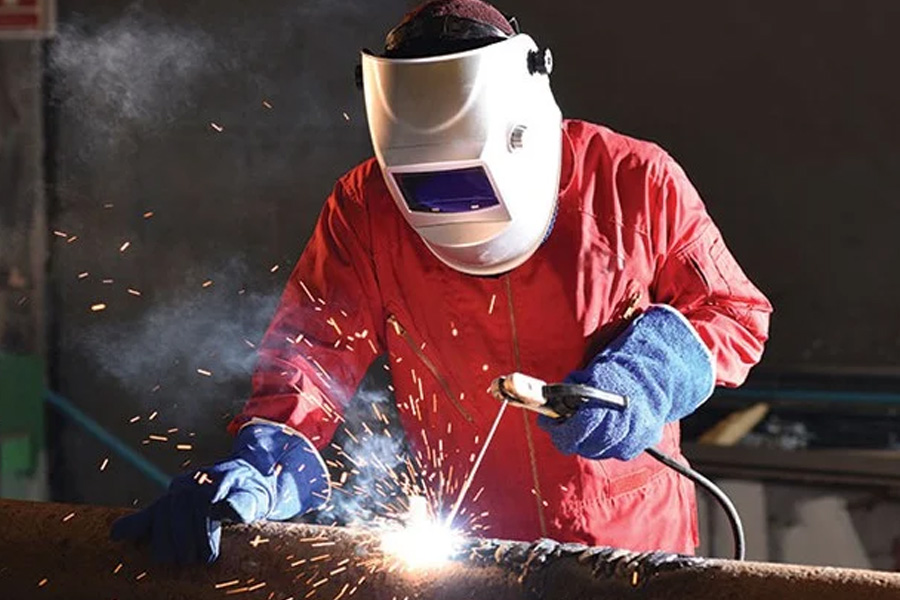
Welding Quality Assurance: Ensuring Excellence in Fabrication
In sectors where metal joining is fundamental, the systematic oversight of fabrication processes is paramount. Industries such as aerospace, construction, and energy rely on the absolute reliability of their structures and components.
A single flaw can lead to disastrous outcomes, from financial losses to risks to human safety. These high-stakes environments demand a rigorous approach that goes beyond simple visual checks.
This systematic approach involves a series of planned activities. It ensures every joint meets its designed purpose, whether supporting a skyscraper or containing high pressures. The goal is consistent excellence and compliance with strict specifications.
Modern methodologies have evolved significantly. They now incorporate advanced technologies to detect imperfections invisible to the naked eye. This proactive focus helps prevent minor issues from escalating into major failures.
Within the UK, businesses adhere to internationally recognised benchmarks while also meeting specific domestic regulations. This dual focus guarantees that products and structures are both safe and competitive on a global scale.
Key Takeaways
- Systematic oversight is critical in high-stakes sectors like aerospace and construction.
- Fabrication flaws can lead to significant safety hazards and financial losses.
- A rigorous approach encompasses checks, inspections, and procedural compliance.
- Advanced technologies are now essential for detecting microscopic imperfections.
- UK industries must comply with both international standards and specific domestic regulations.
- The ultimate goal is to guarantee the integrity and reliability of every fabricated component.
Welding Quality Assurance Best Practices
The foundation of dependable fabrication lies in the meticulous application of proven best practices. These methods ensure every joint meets its required specifications and performs reliably.
A successful system hinges on strict adherence to documented procedures. This covers everything from material preparation to the final post-weld treatments.
Procedure Compliance and Post-Weld Treatments
Following established protocols is non-negotiable for consistent results. These procedures must be regularly reviewed and updated to reflect the latest industry advancements.
Post-Weld Heat Treatment (PWHT) is a critical step for many projects. It involves controlled heating and cooling to relieve internal stresses and enhance material properties.
Proper documentation of the PWHT process is vital. It provides a traceable record, making sure compliance with standards is demonstrable.
Welder Qualification and Continuous Training
The skill of the welder is paramount. Personnel must undergo rigorous qualification processes, with certifications that confirm their competency.
These qualifications need regular review to keep pace with new technologies. Ongoing training for both welders and inspectors is essential for maintaining high standards.
Regular sessions enhance technical skills and reinforce safety. This cultivates a culture of continuous improvement, which is a cornerstone of effective quality control.
Key Elements of Fabrication Best Practices
| Practice Area | Core Focus | Key Benefit |
|---|---|---|
| Procedure Compliance | Adherence to specifications | Predictable, reliable outcomes |
| Post-Weld Heat Treatment | Controlled thermal cycles | Improved material integrity |
| Personnel Qualification | Certified welder competency | Assured workmanship |
| Continuous Training | Skill and knowledge development | Adaptation to new standards |
Industry Standards and Certification Requirements
Certifications and documented procedures transform fabrication from an art into a precise, repeatable science. These frameworks exist to ensure every joint can withstand real-world stresses without failure.
BS EN ISO, ASME and International Guidelines
Key international standards provide the foundation for safe fabrication. AWS D1.1 is non-negotiable for structural steel in buildings and bridges.
For critical sectors like aerospace and energy, ISO 3834 sets out essential requirements. It ensures reliable processes where failure is not an option.
ASME Section IX focuses on pressure applications like boilers and pipelines. It mandates rigorous procedure and performance qualifications.
British standards, including BS EN ISO 15614 and 9606, define specific procedure ranges and welder competencies. Adherence to these industry standards is fundamental for legal and safe operation.
Quality Documentation and Regulatory Compliance
Comprehensive documentation is not optional in high-stakes sectors. Clients require proof that fabrication meets the highest standards.
This paperwork provides a traceable record of compliance. It demonstrates adherence to all applicable welding standards and certification requirements.
Proper records support regulatory audits and ensure public safety. They are a critical component of any robust fabrication management system.
Implementing Non-Destructive Testing for Reliable Welds
The evolution of inspection technologies has revolutionised how internal weld integrity is verified without causing damage. Non-destructive testing (NDT) represents a precise methodology for assessing joint strength by examining subsurface structures.
This approach detects potential flaws that remain invisible through surface inspection alone. It ensures thorough assessment while preserving the original structure’s integrity.
Ultrasonic and Liquid Penetrant Techniques
Ultrasonic testing utilises high-frequency sound waves to penetrate materials. This method provides detailed information about subsurface structures, detecting internal flaws that could compromise integrity.
Liquid penetrant testing involves applying a special liquid to material surfaces. Capillary action draws the penetrant into surface-breaking defects, making cracks clearly visible to inspectors.
Magnetic Particle and Radiographic Methods
Magnetic particle testing detects surface and near-surface defects in ferrous materials. Technicians apply magnetic fields and observe particle accumulation at discontinuities.
Radiographic testing functions similarly to medical X-rays. It reveals internal conditions in thick materials, identifying voids and inclusions within the weld.
Ensuring Safety Through Temperature Control
Thermal monitoring during and after the joining process prevents defects related to excessive heat input. Proper temperature control is critical for maintaining material properties.
While NDT methods dominate modern inspection programmes, destructive testing still plays a role in qualification processes. Test samples undergo extreme conditions to verify that procedures produce acceptable results.
Optimising Welding Procedures and Documentation
Modern fabrication management relies on two pillars: precise operational procedures and comprehensive record systems. These elements transform individual tasks into a cohesive, repeatable production process.
They ensure every project meets its design specifications reliably. This systematic approach underpins operational excellence across the industry.
Establishing Robust Welding Procedure Specifications (WPS)
A Welding Procedure Specification (WPS) acts as the definitive rulebook for each joint. It documents critical variables like amperage, voltage, and temperature controls.
This eliminates guesswork, ensuring the welding process follows a proven methodology. Robust WPS development requires qualification testing to demonstrate the procedure produces sound results.
These specifications must be accessible to all personnel and regularly reviewed. Updates incorporate technological advances and lessons from production experience.
Comprehensive Record-Keeping and Calibration Practices
Meticulous documentation creates an essential digital trail for every component. It records the specific welding procedure used, inspection results, and any corrective actions.
This supports full traceability and facilitates audits. Regular calibration of equipment is equally critical for measurement precision.
Established maintenance schedules verify that instruments perform within specified tolerances. This systematic approach provides data for trend analysis, enabling continuous improvement.
Core Components of Procedural and Documentation Systems
| System Element | Primary Function | Impact on Outcome |
|---|---|---|
| Welding Procedure Specification (WPS) | Defines approved methods and parameters | Ensures process consistency and repeatability |
| Procedure Qualification Record (PQR) | Provides evidence of WPS validity | Demonstrates procedure meets required standards |
| Comprehensive Documentation | Creates an auditable trail for each weld | Enables traceability and supports compliance |
| Equipment Calibration | Verifies measurement instrument accuracy | Guarantees data precision and reliability |
The Role of Automation and Technological Advances in Welding
A fundamental shift is reshaping fabrication oversight, moving from reactive inspections to proactive, technology-driven control. Automation and artificial intelligence now play a critical role in achieving unprecedented levels of consistency.
These systems prevent defects before they occur, ensuring every joint meets its design specifications.
AI-Driven Machine Vision and Real-Time Adjustments
Artificial intelligence utilises advanced image recognition to scan the weld pool in real-time. It instantly identifies irregularities like porosity or incomplete fusion that human eyes might miss.
Machine learning algorithms analyse historical data to optimise the process. They automatically adjust heat settings and wire feed speed for optimal results.
This real-time tracking monitors weld integrity as it happens. It allows for immediate corrections, preventing flawed welds from progressing.
Robotic Welding Systems for Consistent Quality
Robotic systems execute joins with exceptional precision. They follow exact parameters for every operation, eliminating the variability of manual techniques.
Laser seam tracking technology enables these robots to make micro-adjustments on the fly. This maintains perfect torch positioning for consistent penetration.
IoT sensors monitor critical variables like gas flow and temperature. This continuous data stream supports both immediate control and long-term analysis for sustained quality.
Real-World Case Studies and Expert Insights
Historical incidents of structural failure powerfully illustrate the non-negotiable need for rigorous fabrication oversight. These events move theory into stark reality, demonstrating the profound consequences when standards are not met.
Learning from past mistakes is crucial for advancing industry practices and safeguarding lives.
Expert Perspectives from NWQS Ltd
Specialist firms like NWQS Ltd provide invaluable insights into implementing robust systems. Their expertise spans non-destructive testing, personnel qualifications, and procedural compliance.
They emphasise that demonstrable competency through performance qualifications is a cornerstone of reliable outcomes. This ensures personnel can consistently execute to specification.
Benchmarking Success with NWQS
Organisations that partner with specialists like NWQS often see measurable improvements. These include significantly reduced defect rates and enhanced structural integrity.
Systematic implementation of best practices leads to superior regulatory compliance. It builds a culture of continuous improvement.
Case Studies Highlighting NWQS Ltd Advances
Documented failures underscore the importance of advanced methodologies. Several high-profile cases highlight what can go wrong:
- The Big Dig Ceiling Collapse (2006): Poorly executed joins on steel anchors led to fatal concrete panel falls.
- Keystone Pipeline Spills: Defective joins caused catastrophic oil spills, often preventable with better monitoring.
- Wright “B” Flyer Replica Crash: A faulty propeller shaft join, weakened over time, resulted in a fatal mid-air failure.
These examples show that in sectors like aerospace and energy, certifications are essential for proving join integrity.
Innovative Trends with NWQS
The future of fabrication oversight lies in technology integration. Companies are increasingly adopting AI-driven systems for real-time defect detection.
This shift towards data-driven process optimisation represents the next evolution in reliable fabrication. It complements the timeless fundamentals of proper planning and meticulous documentation.
Conclusion
Fabrication integrity represents more than technical compliance—it embodies a fundamental duty to public safety. The distinction between reliable structures and potential disasters rests on comprehensive oversight systems that leave nothing to chance.
Modern approaches integrate advanced technologies with proven methodologies to verify every join. Artificial intelligence and automation complement skilled personnel, providing consistent monitoring that exceeds human limitations alone.
This systematic verification process ensures material performance meets design specifications. It represents an ongoing commitment to excellence rather than a final destination.
Investing in robust oversight delivers measurable returns through enhanced safety and reduced failures. The ultimate goal remains unwavering: making sure every fabricated component performs as intended throughout its service life.
FAQ
What are the fundamental components of a robust welding quality system?
A strong system integrates several key elements. These include strict adherence to approved procedures, comprehensive welder performance qualifications, meticulous documentation, and consistent non-destructive testing. This multi-layered approach ensures every weld meets the highest standards for integrity and safety.
Which industry standards are most critical for welding integrity?
Key standards governing fabrication include BS EN ISO 3834, ASME Boiler and Pressure Vessel Code, and various AWS codes. Compliance with these international guidelines is essential for regulatory approval and guarantees that materials and processes are fit for purpose across different sectors.
How does non-destructive testing contribute to weld reliability?
Non-destructive testing (NDT) methods, such as ultrasonic and radiographic inspection, are vital for verifying internal soundness without damaging the component. These techniques detect hidden flaws like cracks or inclusions, providing crucial data to confirm a weld’s structural integrity before it enters service.
Why is proper documentation so important in the welding process?
Thorough record-keeping provides a complete audit trail. It demonstrates compliance with specifications, tracks material certifications, and logs inspection results. This documentation is critical for traceability, liability protection, and proving that all work was performed to the required quality benchmarks.
What role does technology play in modern quality assurance?
Technological advances, such as robotic welding systems and AI-driven monitoring, significantly enhance precision and consistency. Automation reduces human error, while real-time data analysis allows for immediate adjustments, leading to superior performance and repeatability in fabrication projects.



